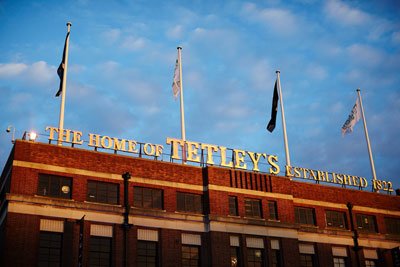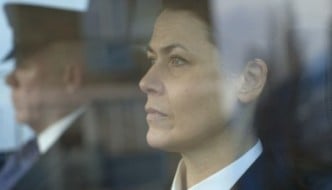Another Lease of Life for The Tetley
July 14, 2014
Edmund Francis exudes artist chic with his tousled hair, a pen behind his left ear and his brown leather work boots, battle-scarred with paint. Francis comes across as calm and modest and appears to be a mine of rich, conceptual ideas.
Currently exhibiting his show Lease as part of A New Reality: Part 3, the last component of The Tetley’s inaugural programme, Francis demonstrates his love of combining traditional design with modern techniques of industrial manufacture, while manipulating size and purpose. For example, his Anglepoise Desk Light, which is seven times larger than a standard Anglepoise lamp,created a technical challenge for the artist as he wanted to get involved in something ‘big and laborious’ and says he was ‘fascinated by its workings’. Buying the nuts and bolts intended for shipping containers and getting springs specially made in the correct size and strength, Francis made everything else himself using plywood, fibreglass and plastic boat resin.
Francis refers to the way in which an object functions as a status symbol when he discusses the ‘middle-class satisfaction with an anglepoise’, and how it was a ‘mark of acceptance’ into the middle-class club. The artist admits when exhibiting this piece, ‘it’s quite rare to get such a big space’, and explains how the balconied atrium space in The Tetley means the viewer ‘can look at it from all different angles’. The vast sculpture requires ‘a couple of days’ work to assemble, clap and hit together’ details Francis, while highlighting that the wear it has seen through this process and transport in a transit van has ‘added to its authenticity’. Describing this design of the lamp as being ‘synonymous with the office’, and therefore an appropriate item to be displayed in the former Tetley headquarters, Francis explains that the rest of the exhibition is ‘in response to the building and looking into the history of it’.
Coming from a carpentry and joinery background, Francis says that he is ‘trying to mix [his] carpentry stuff’ with his artistic practice. Another of his works which has employed innovative methods of manufacture is Plastic Windsor Chairs. Francis states that in this case he was ‘trying to emulate the ubiquitous flowing white plastic chair’ and says ‘the reason [commonplace white plastic chairs] look so old is because you leave them out in your garden’. Working with the aesthetic of crisp white plastic with a pristine glossy surface, he has created farmhouse Windsor chairs. Taking apart a traditional wooden piece of furniture, Francis cast new descendants of the historic design from the component parts in a modern material. He says he was ‘trying to do an old-fashioned technical construction with a new material’ and ‘I like chairs not being used for their purpose’. One of the two chairs is presented standing on the wood of the parquet flooring and the other hung on a thick wooden peg (found in the basement of The Tetley) against the toffee-coloured dado panelling as Francis is ‘happy with them being against complex woodwork’.
Again Francis praises the capabilities of The Tetley as an environment for displaying contemporary art, preferring what it offers to a white cube space: ‘There’s something quite good about having older stuff in this environment… It’s not over-cleansed of character as a lot of galleries are’. He explains that to present art well ‘you inevitably have to work with the space in some way, you can’t dominate the environment – you have to work with it’. Francis also reveals that elements of joinery in the fabric of The Tetley have given him inspiration for other projects.
Other concepts in Lease include the examination of collecting and hoarding as positive and negative processes which are tied to class, subculture and money. There is also a sound installation meant to act as a time capsule preserving analogue radio. This is intended to be played to gallery goers and act as a distracting or disturbing background noise in order to affect how they perceive what they see.
Francis, in his most successful pieces, makes us examine the mundane in a new light, with his technical abilities and craftsmanship clearly evident in his work.
Helena Roddis
Filed under: Art & Photography
Tagged with: The Tetley



Comments